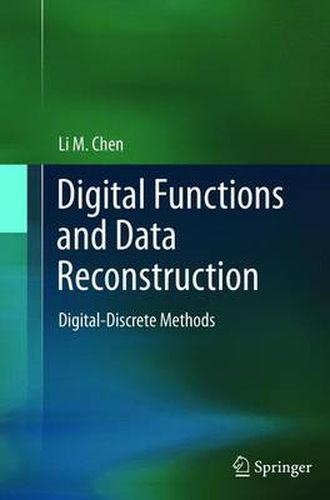Readings Newsletter
Become a Readings Member to make your shopping experience even easier.
Sign in or sign up for free!






This title is printed to order. This book may have been self-published. If so, we cannot guarantee the quality of the content. In the main most books will have gone through the editing process however some may not. We therefore suggest that you be aware of this before ordering this book. If in doubt check either the author or publisher’s details as we are unable to accept any returns unless they are faulty. Please contact us if you have any questions.
Digital Functions and Data Reconstruction: Digital-Discrete Methods provides a solid foundation to the theory of digital functions and its applications to image data analysis, digital object deformation, and data reconstruction. This new method has a unique feature in that it is mainly built on discrete mathematics with connections to classical methods in mathematics and computer sciences.
Digitally continuous functions and gradually varied functions were developed in the late 1980s. A. Rosenfeld (1986) proposed digitally continuous functions for digital image analysis, especially to describe the continuous component in a digital image, which usually indicates an object. L. Chen (1989) invented gradually varied functions to interpolate a digital surface when the boundary appears to be continuous. In theory, digitally continuous functions are very similar to gradually varied functions. Gradually varied functions are more general in terms of being functions of real numbers; digitally continuous functions are easily extended to the mapping from one digital space to another.
This will be the first book about digital functions, which is an important modern research area for digital images and digitalized data processing, and provides an introduction and comprehensive coverage of digital function methods. Digital Functions and Data Reconstruction: Digital-Discrete Methods offers scientists and engineers who deal with digital data a highly accessible, practical, and mathematically sound introduction to the powerful theories of digital topology and functional analysis, while avoiding the more abstruse aspects of these topics.
$9.00 standard shipping within Australia
FREE standard shipping within Australia for orders over $100.00
Express & International shipping calculated at checkout
This title is printed to order. This book may have been self-published. If so, we cannot guarantee the quality of the content. In the main most books will have gone through the editing process however some may not. We therefore suggest that you be aware of this before ordering this book. If in doubt check either the author or publisher’s details as we are unable to accept any returns unless they are faulty. Please contact us if you have any questions.
Digital Functions and Data Reconstruction: Digital-Discrete Methods provides a solid foundation to the theory of digital functions and its applications to image data analysis, digital object deformation, and data reconstruction. This new method has a unique feature in that it is mainly built on discrete mathematics with connections to classical methods in mathematics and computer sciences.
Digitally continuous functions and gradually varied functions were developed in the late 1980s. A. Rosenfeld (1986) proposed digitally continuous functions for digital image analysis, especially to describe the continuous component in a digital image, which usually indicates an object. L. Chen (1989) invented gradually varied functions to interpolate a digital surface when the boundary appears to be continuous. In theory, digitally continuous functions are very similar to gradually varied functions. Gradually varied functions are more general in terms of being functions of real numbers; digitally continuous functions are easily extended to the mapping from one digital space to another.
This will be the first book about digital functions, which is an important modern research area for digital images and digitalized data processing, and provides an introduction and comprehensive coverage of digital function methods. Digital Functions and Data Reconstruction: Digital-Discrete Methods offers scientists and engineers who deal with digital data a highly accessible, practical, and mathematically sound introduction to the powerful theories of digital topology and functional analysis, while avoiding the more abstruse aspects of these topics.